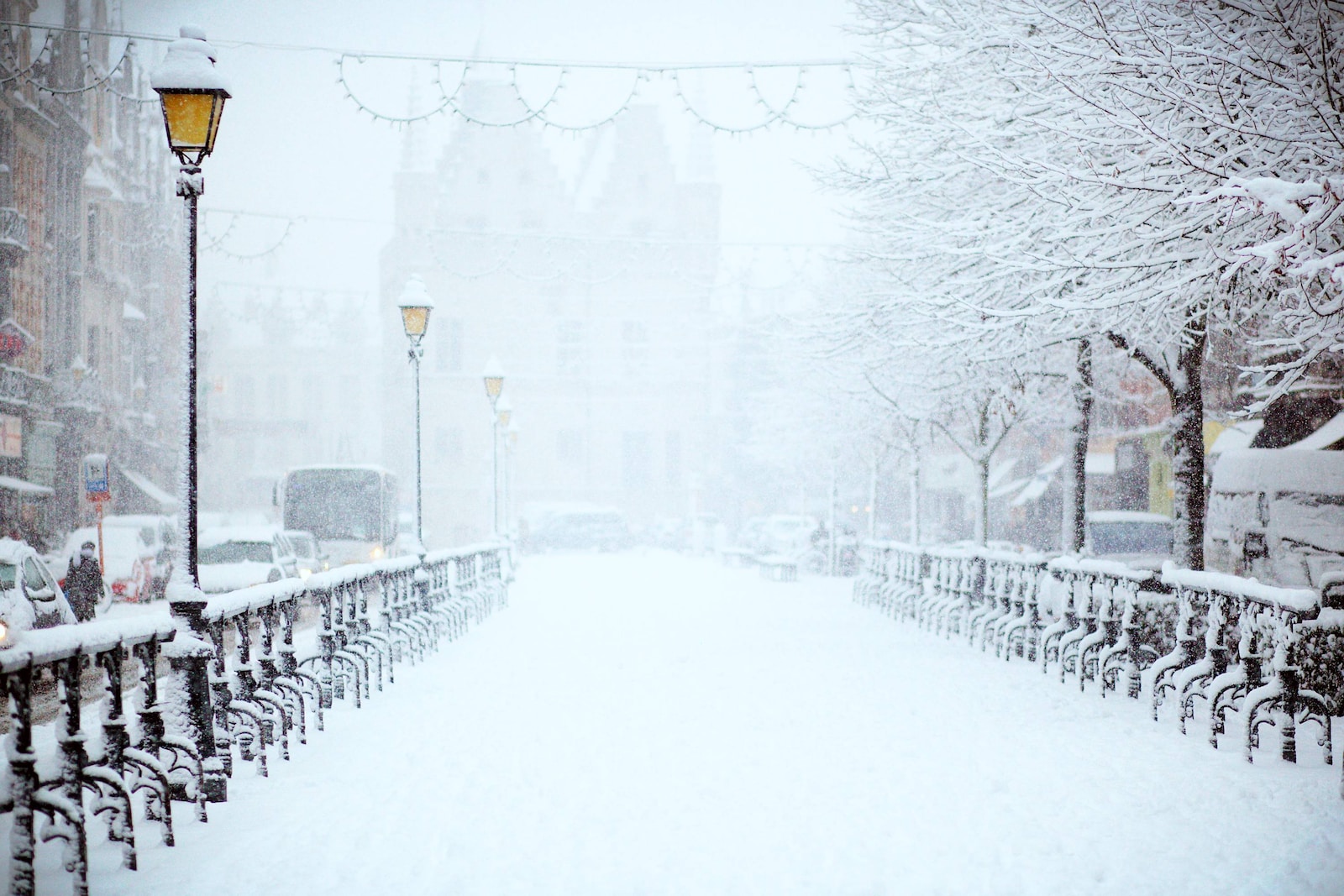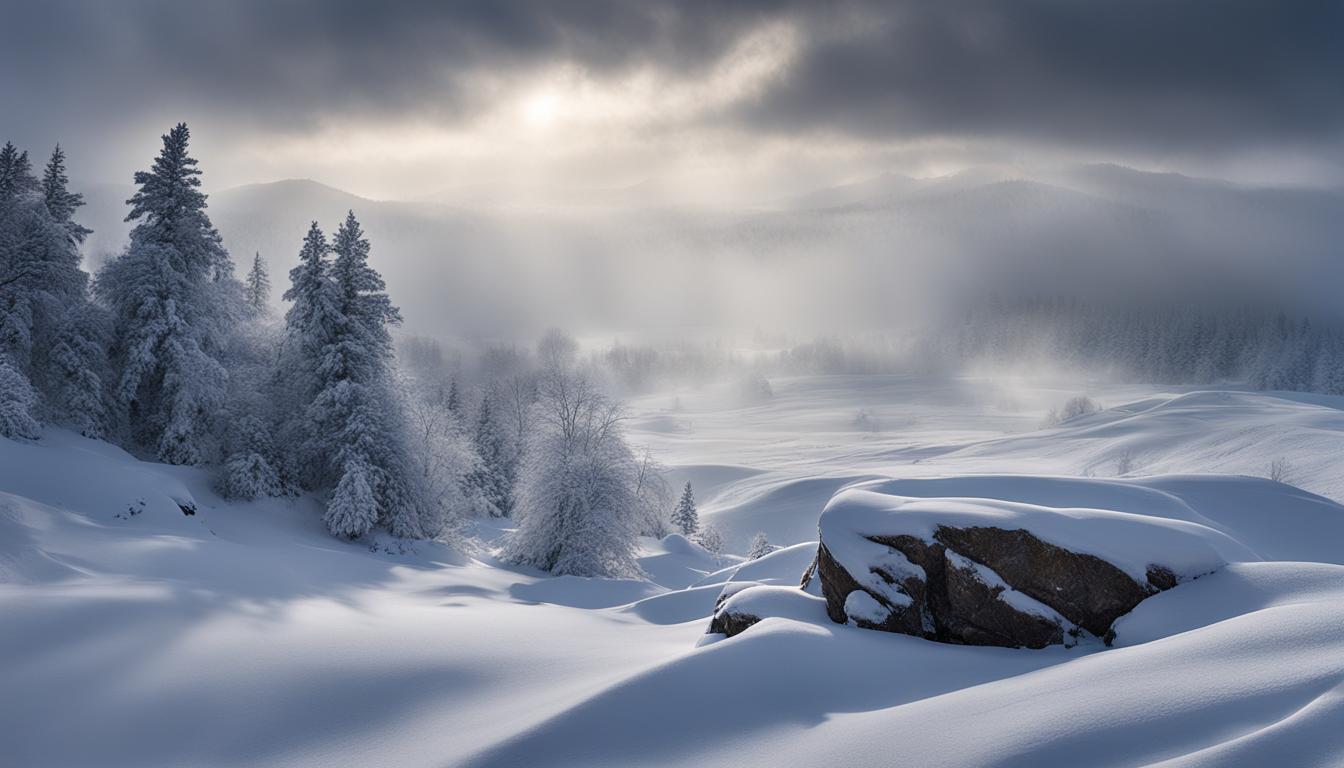Winter weather can be unpredictable and can bring a variety of conditions. Two phenomena that often occur during the winter season are snow squalls and flurries. While these two weather events may seem similar, they have distinct characteristics that set them apart.
In this section, we will explore the differences between snow squalls and flurries, their definitions, and what sets them apart from each other.
Key Takeaways:
- Snow squalls and flurries are both winter weather events, but they have distinct characteristics that differentiate them from each other.
- Snow squalls are characterized by intense, localized bursts of snow that can cause dangerous driving conditions and reduced visibility.
- Flurries, on the other hand, are light, scattered snow that typically don’t cause travel problems.
- Understanding the differences between snow squalls and flurries can help you better prepare for and navigate winter weather.
What Are Snow Squalls?
Winter weather can bring a variety of different phenomena, including snow squalls. These intense bursts of snow can cause significant disruptions to travel and daily activities. Understanding their characteristics is important for staying safe during winter weather events.
Snow squall characteristics:
| Characteristic | Description |
|---|---|
| Duration | Snow squalls typically last between 30 minutes to an hour, but can occasionally persist for several hours. |
| Intensity | Snow squalls are characterized by intense snowfall rates of 1-2 inches per hour or more, often accompanied by gusty winds. |
| Impact on visibility | The intense snowfall rates of snow squalls can lead to significant reductions in visibility, sometimes resulting in whiteout conditions. |
| Formation | Snow squalls are typically associated with the passage of a cold front and can occur in a variety of meteorological conditions, including in both lake-effect and non-lake-effect snow situations. |
When a snow squall is forecast, it is important to prepare accordingly. If possible, avoid traveling during the storm and stay indoors until it has passed. If you must travel, make sure your vehicle is equipped for winter weather conditions and drive slowly and cautiously.
What Are Flurries?
Flurries are a common winter weather phenomenon that brings light snowfall and a dusting of snow over the ground. Unlike snow squalls, flurries are typically less intense and shorter in duration. They can occur in a variety of weather conditions and temperatures, ranging from clear, cold days to cloudy, mild days.
The distinguishing characteristic of a flurry is the size of the snowflakes. Flurries produce small, delicate snowflakes that often resemble ice crystals. They tend to fall slowly and can drift with the wind before settling on the ground.
Flurries can be fascinating to watch, especially when they are illuminated by streetlights or other sources of light. They can create a magical winter atmosphere and are often associated with the holiday season. However, they can also have a significant impact on travel conditions, especially when they occur in large numbers.
Flurries can cause roads and sidewalks to become slick and icy, making it difficult to drive or walk safely. They can also affect visibility, reducing the ability to see ahead while driving or walking. Despite their relatively mild nature, it is essential to take precautions when flurries are expected in your area.
Overall, flurries are a beloved part of winter for many people. While they may not be as dramatic as snow squalls, they are a reminder of the beauty and wonder of winter weather.
Key Differences Between Snow Squalls and Flurries
While snow squalls and flurries may both involve snow falling from the sky, there are several key differences between these two winter weather phenomena. These differences can impact the intensity, duration, and impact on visibility and travel conditions.
Intensity: Snow squalls are characterized by sudden and intense bursts of snow, often with high winds and reduced visibility. Flurries, on the other hand, are lighter and more scattered snowfall, with less impact on travel conditions.
Duration: Snow squalls are typically short-lived, lasting anywhere from 15 minutes to an hour. Flurries, on the other hand, can last for hours or even days, but with less intensity than snow squalls.
Visibility: Snow squalls can cause whiteout conditions, reducing visibility to near zero. Flurries may cause reduced visibility, but generally not to the same extent as snow squalls.
Impact on Travel: Snow squalls can cause hazardous driving conditions, with slick roads, reduced visibility, and sudden changes in weather. Flurries may cause some slippery spots, but are generally less likely to impact travel conditions.
Key Takeaway
Difference Between Snow Squalls and Flurries: Snow squalls are intense, short-lived bursts of snowfall, while flurries are lighter and more prolonged snowfall with less impact on travel conditions. Understanding these differences is essential for preparedness during winter weather events.
Snow Squall vs Snow Shower
While both snow squalls and snow showers are winter weather phenomena that involve snowfall, there are significant differences between the two. A snow squall is a sudden and intense burst of snowfall, with a sudden drop in visibility and gusty winds. In contrast, a snow shower is a more widespread snowfall that is generally less intense than a snow squall.
Snow showers are characterized by light to moderate snowfall, which may last for varying durations. They are usually associated with colder temperatures and can occur in both cloudy and clear skies. Snow showers are typically more predictable and easier to forecast than snow squalls, which can occur with little warning.
On the other hand, snow squalls are more intense and can last anywhere from a few minutes to an hour. They are usually accompanied by gusty winds, which can result in significant drifting and blowing snow. Snow squalls often reduce visibility rapidly and can make driving conditions treacherous.
While both snow squalls and snow showers are conditions that can affect visibility and road conditions, it’s essential to understand the differences to be better prepared during winter months.
Duration of Snow Squalls and Flurries
The duration of snow squalls and flurries can vary depending on several factors. Generally, flurries are shorter in duration and last for a few minutes to a couple of hours. On the other hand, snow squalls can last for several hours and may persist for a day or more.
The duration of both snow squalls and flurries can be influenced by the intensity of the precipitation and the atmospheric conditions. For instance, snow squalls can intensify rapidly due to certain atmospheric conditions and, this may result in longer-lasting events. Similarly, flurries may persist longer if the atmospheric temperature and moisture content are conducive to snowfall.
It is important to note that the duration of snow squalls and flurries can have a significant impact on travel and visibility. Short-lived flurries may not cause significant disruptions to daily activities, but snow squalls that persist for several hours can result in snow accumulations and hazardous road conditions. Therefore, it is crucial to pay attention to weather forecasts and take appropriate precautions during wintertime.
Impact of Snow Squalls and Flurries
Winter weather can bring a host of challenges, particularly when it comes to snow squalls and flurries. These weather phenomena can have a significant impact on daily activities and travel conditions.
Snow Squall Characteristics
Snow squalls can create sudden and dramatic changes in weather conditions. These intense snow showers are characterized by heavy snowfall rates and strong, gusty winds. Snow squalls can cause significant reductions in visibility, which can make driving and other outdoor activities hazardous. In addition, the rapid accumulation of snow can create slick and slippery road conditions, making travel difficult and potentially dangerous.
Flurry Characteristics
Flurries, on the other hand, are much lighter and less intense than snow squalls. They typically produce light snowfall and don’t usually last very long. While flurries can cause light accumulations of snow, they generally don’t have a significant impact on travel conditions or daily activities.
Both snow squalls and flurries can have a varying impact, depending on the amount of snowfall, wind speeds, and other weather conditions. While flurries may seem less significant than snow squalls, they can still create slippery conditions on roads and sidewalks, so it’s important to take precautions when traveling during any winter weather event.
Conclusion
Understanding the difference between snow squalls and flurries is crucial for anyone living in a region that experiences harsh winter weather. While both phenomena involve the falling of snow, they differ in intensity, duration, and impact on visibility and travel conditions.
Snow squalls are intense and fast-moving winter storms that can cause sudden and significant reductions in visibility, making them hazardous for drivers. Flurries, on the other hand, are light snowfall that typically last for a shorter period and have less impact on visibility and travel conditions.
It’s important to note that snow squalls can also be confused with more widespread snow showers, which have a more extended duration and lower intensity compared to squalls.
Although snow squalls and flurries can be beautiful to watch from inside a warm house, they have the potential to cause severe travel restrictions and dangerous conditions if not prepared for properly. So, knowing the difference between the two will help people be better prepared for winter weather and lower the risk of accidents.
In summary, being aware of the differences between snow squalls and flurries is crucial to stay safe during the cold winter months. It’s important to monitor local weather reports and take necessary precautions to ensure personal safety and minimize any possible impact on travel plans or daily activities.
FAQ
Q: What is the difference between snow squalls and flurries?
A: Snow squalls and flurries are both winter weather phenomena, but they have distinct characteristics. Snow squalls are intense bursts of snowfall accompanied by strong winds, whereas flurries refer to light and scattered snow showers. Snow squalls typically have a shorter duration and can significantly reduce visibility, while flurries are more widespread and have less impact on visibility.
Q: What are snow squalls?
A: Snow squalls are intense bursts of snowfall accompanied by strong winds. They often occur in cold air masses and can result in rapidly changing weather conditions. Snow squalls can significantly reduce visibility and create hazardous travel conditions.
Q: What are flurries?
A: Flurries refer to light and scattered snow showers. They are usually less intense than snow squalls and can occur in various weather patterns. Flurries may result in a dusting of snow but typically have minimal impact on visibility and travel conditions.
Q: What are the key differences between snow squalls and flurries?
A: The key differences between snow squalls and flurries lie in their intensity, duration, and impact on visibility and travel conditions. Snow squalls are more intense, have a shorter duration, and can greatly reduce visibility and create hazardous road conditions. On the other hand, flurries are lighter, more scattered, and have minimal impact on visibility and travel.
Q: What is the difference between snow squalls and snow showers?
A: Snow squalls and snow showers can be differentiated by their intensity and geographic coverage. Snow squalls are intense bursts of snowfall accompanied by strong winds and often have localized impacts. Snow showers, on the other hand, refer to more widespread snowfall that covers a larger geographic area.
Q: How long do snow squalls and flurries typically last?
A: The duration of snow squalls and flurries can vary depending on various factors such as atmospheric conditions and geographic location. However, snow squalls usually last for a shorter period, often ranging from a few minutes to a couple of hours. Flurries, on the other hand, can persist for a longer duration, lasting anywhere from a few hours to several days.
Q: What is the impact of snow squalls and flurries?
A: Snow squalls and flurries can both have an impact on visibility, road conditions, and daily activities. Snow squalls, with their intense snowfall and strong winds, can significantly reduce visibility and create hazardous driving conditions. Flurries, although less intense, can still contribute to reduced visibility and may result in some accumulation of snow on surfaces.



